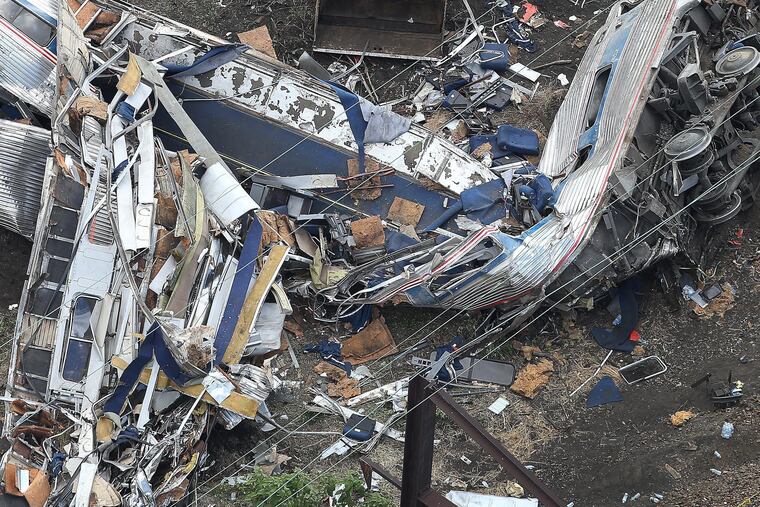Reckless or disoriented? The 2015 Amtrak crash trial opens with dueling visions of the engineer
Prosecutors say Brandon Bostian was reckless when he crashed a speeding train in Frankford. But his attorneys say he was thrown off by reports that another nearby train was struck by rocks.

Brandon Bostian failed to do his job — and people died and were injured as a result.
Prosecutors say that’s the simple fact they’ll prove at Bostian’s trial in the coming days: that Bostian, an Amtrak engineer thoroughly trained to navigate a train along the Northeast Corridor, failed in his basic duty to direct Train 188 safely from 30th Street Station to New York City on May 12, 2015.
On that night, Senior Deputy Attorney General Christopher Phillips told jurors during opening arguments Friday, Bostian accelerated to double the speed limit ahead of a curve in Frankford. And as a result of that act — which Phillips said was clearly negligent — the seven-car train went careening off the tracks, leaving eight people dead and more than 200 injured, and creating a disaster unlike anything in recent city history.
“The law recognizes that sometimes, even in an accident, our conduct is so reckless, so grossly negligent, that it becomes a crime,” Phillips said. “That’s what this case is.”
But Bostian’s lawyer, Brian McMonagle, told jurors that if anyone committed a crime that night, it wasn’t Bostian.
As Bostian pulled out of 30th Street, McMonagle said, a SEPTA train a few minutes ahead on the rails came “under attack.” People had thrown rocks at that train, McMonagle said, shattering its windshield and causing it to make an emergency stop. The SEPTA engineer reported the situation over the radio, McMonagle said, flustering Bostian and causing him to lose his bearings.
The result was that Bostian, an otherwise conscientious engineer with a sterling history, made an honest mistake, McMonagle said. He wasn’t negligent, McMonagle said — he was reacting to the behavior of “criminals,” never identified, who decided to endanger moving trains by lobbing rocks toward them.
“At the end of this case you’re going to realize that this was a terrible accident caused by someone else,” McMonagle said. “And not a crime by [Bostian].”
The opening salvos kicked off testimony in Bostian’s trial, a case that could send the 38-year-old former engineer to prison — or clear his name of criminal wrongdoing after a long and unusual legal ordeal.
Bostian faces eight counts of involuntary manslaughter, more than 200 counts of reckless endangerment, and a charge of causing a catastrophe, a felony.
On Thursday, just before the jury of eight women and four men was selected, Bostian rejected a plea offer that could have spared him years behind bars. Common Pleas Court Judge Barbara McDermott told Bostian that prosecutors would have allowed him to plead “no contest” to nine counts of reckless endangerment, but Bostian decided to take the case before a jury.
Prosecutors have not said what sentence they might seek upon conviction, but McDermott said Bostian was exposing himself to potential prison time if the panel finds him guilty.
His case has taken an unusual path toward trial: It’s been thrown out twice before by judges, each of whom said Bostian’s conduct was not criminal. But the Attorney General’s Office has successfully appealed those decisions to revive the case.
During his opening argument Friday, Phillips, the prosecutor, sought to bolster his case by telling jurors that Bostian told passenger Blair Berman they were at the Frankford curve after the crash — evidence, Phillips said, that Bostian was not disoriented, even though he later asked police if he was in New York.
Phillips also said Bostian had operated the train within the speed limits until shortly before the crash, which Phillips said demonstrated that Bostian was not confused while navigating the train.
But McMonagle cited that same record of safe travel as evidence that Bostian was clearly thrown off by the reports of rock throwing. And he pointed out that investigators with the National Transportation Safety Board later found that Bostian was not intoxicated or using his cell phone before the crash.
Testimony opened with accounts from three Philadelphia crime scene officers, a bomb squad investigator — who’d searched the crash site to ensure it wasn’t a terrorist attack — and an assistant medical examiner, who reviewed the autopsy reports of the deceased victims.
Berman took the witness stand and said she didn’t remember the moment of impact. But she described having to crawl out from under several people in the pitch black after the derailment, finding a tree branch to hoist herself up on due to injuries she suffered to her right side.
She then had a chance encounter with Bostian, she said, and used his phone to call her father because hers had been lost during the crash.
She said Bostian did not identify himself as an Amtrak employee, but told Berman they were at Frankford Junction. When her call was over, she said, Bostian walked away.
“I just waited until I got help,” Berman said.
Family members and supporters of both Bostian and some victims in the case were spread across two courtrooms Friday to watch a livestream of the proceedings. Due to pandemic restrictions, the courtroom itself was limited to lawyers, witnesses, and jurors.